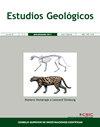Caracterización mineralógica y geoquímica de minerales hidratados de ambientes subterráneos: implicaciones para la exploración planetaria
IF 0.8
4区 地球科学
Q3 GEOLOGY
引用次数: 5
Abstract
The recent discovery of hydrated sulfates on the Martian surface suggests that widespread wet conditions were present during its early geological history. Upon this discovery, a growing interest has emerged in the study of this group of minerals from terrestrial environments as potential Martian analogs. Here, we evaluate the potential of various analytical techniques involved in current and future mission to Mars for detecting hydrated minerals from caves and mines of Spain and the mining district of Iglesias-Carbonia (Sardinia, Italy). Minerals were analyzed by Raman spectroscopy, which will be included in the payload of the ESA’s 2018 ExoMars mission. On the other hand, IR spectroscopy, also included in the ExoMars mission, as well as LIBS spectroscopy and a combined XRD-XRF analyzer, both onboard the Curiosity rover of NASA’s MSL mission, were utilized. Hydrated sulfates (gypsum, epsomite, jarosite and glaucocerinite), silicates (hemimorphite) and carbonates (hydrozincite and hydromagnesite) were characterized. Most of these minerals have also been detected on the Martian surface. The mechanisms involved in the genesis of these minerals and the potential analogies with the minerogenesis on Mars are discussed. The Raman-LIBS combination appears to be the most powerful tool for detecting hydrated minerals in Martian conditions. This technology will probably be considered to be onboard of further planetary missions.地下环境水合矿物的矿物学和地球化学特征:对行星探索的启示
最近在火星表面发现的水合硫酸盐表明,在火星早期的地质历史中,普遍存在着潮湿的环境。在这一发现之后,越来越多的人对研究这组来自陆地环境的矿物作为潜在的火星类似物产生了兴趣。在这里,我们评估了目前和未来火星任务中涉及的各种分析技术的潜力,用于探测西班牙和伊格莱西亚斯- carbonia矿区(撒丁岛,意大利)的洞穴和矿山中的水合矿物。矿物被拉曼光谱分析,这将包括在欧空局2018年ExoMars任务的有效载荷中。另一方面,ExoMars任务也使用了红外光谱,以及LIBS光谱和XRD-XRF组合分析仪,这两种仪器都搭载在美国宇航局火星科学实验室任务的好奇号漫游车上。水合硫酸盐(石膏、泻石、黄钾铁矾和青铜石)、硅酸盐(半铁锌矿)和碳酸盐(氢锌矿和氢菱镁矿)进行了表征。这些矿物中的大多数也在火星表面被探测到。讨论了这些矿物形成的机制,并与火星上的矿物形成进行了潜在的类比。Raman-LIBS组合似乎是探测火星条件下水合矿物的最有力工具。这项技术可能会被考虑用于未来的行星任务。
本文章由计算机程序翻译,如有差异,请以英文原文为准。
求助全文
约1分钟内获得全文
求助全文
来源期刊

Estudios Geologicos-Madrid
GEOLOGY-
CiteScore
1.40
自引率
14.30%
发文量
6
审稿时长
>12 weeks
期刊介绍:
Since 1945 Estudios Geologicos publishes original research works, as well as reviews, about any topic on Earth Sciences.
Estudios Geologicos is published as one yearly volume, divided into two half-yearly issues. It is edited by the Spanish National Research Council (Consejo Superior de Investigaciones Científicas, CSIC) at the Instituto de Geociencias (CSIC-UCM).
Estudios Geologicos provides free access to full-text articles through this electronic edition. Accepted articles appear online as "Forthcoming articles" as soon as the galley proofs have been approved by the authors and the Editor-in-Chief. No changes can be made after online publication.
 求助内容:
求助内容: 应助结果提醒方式:
应助结果提醒方式:


